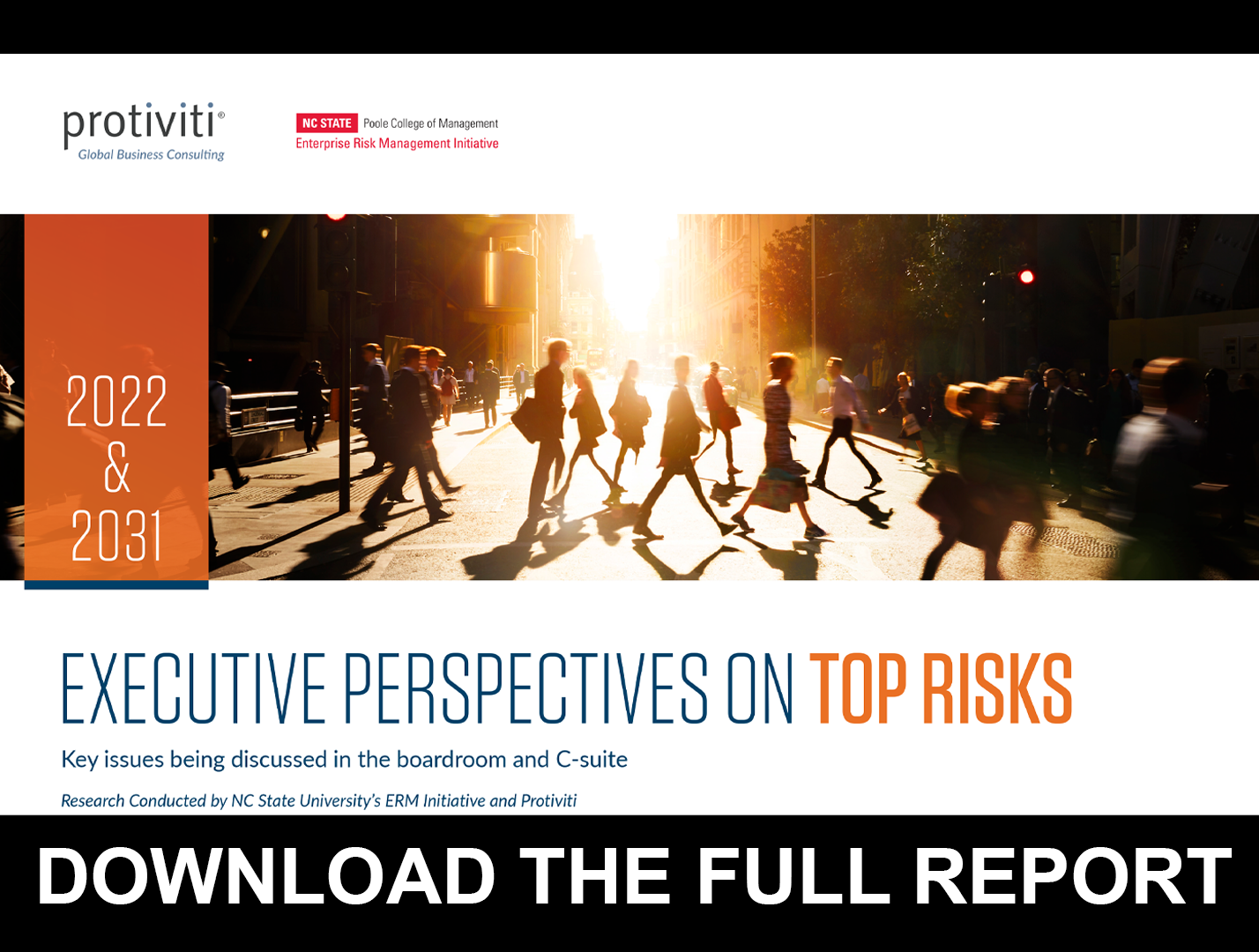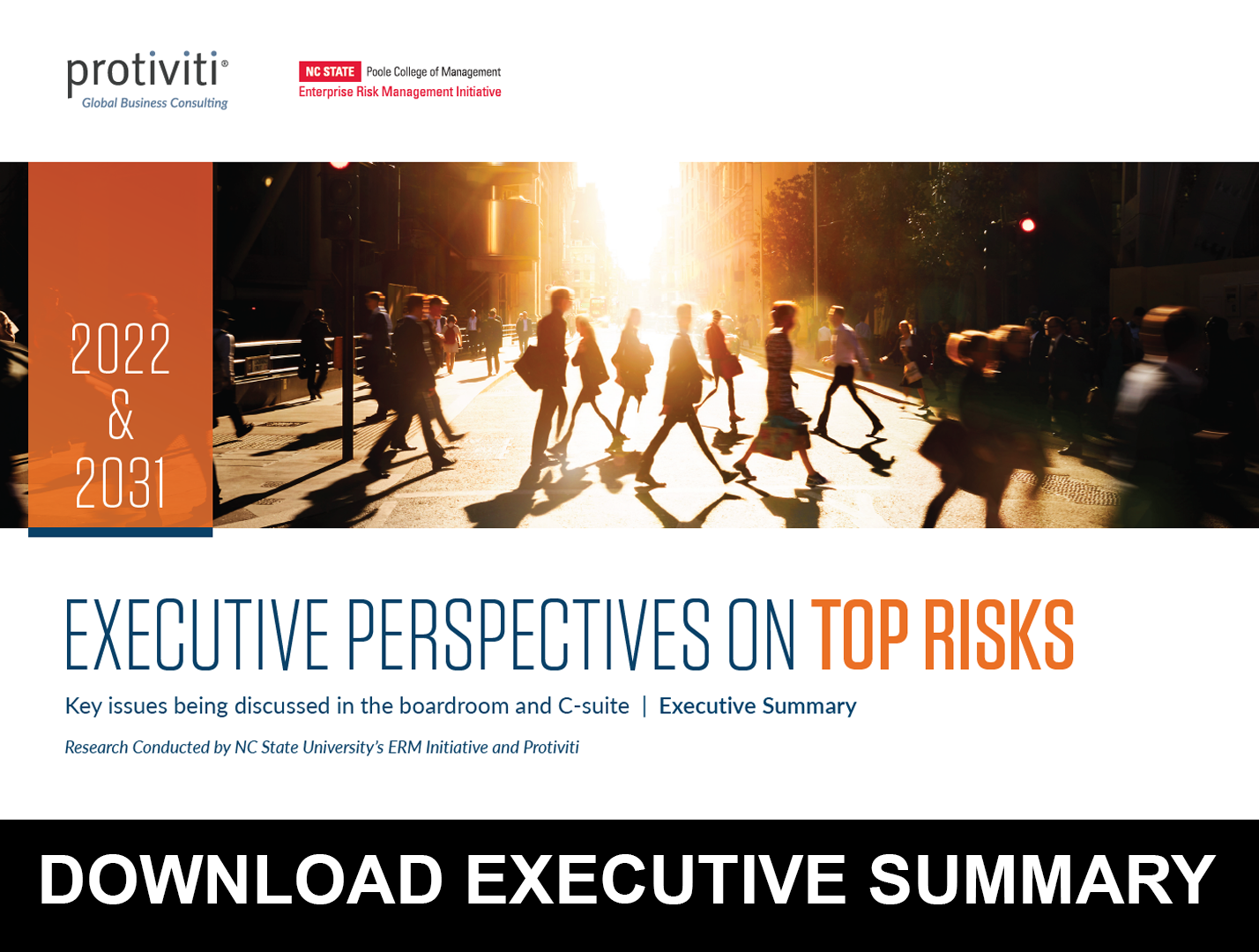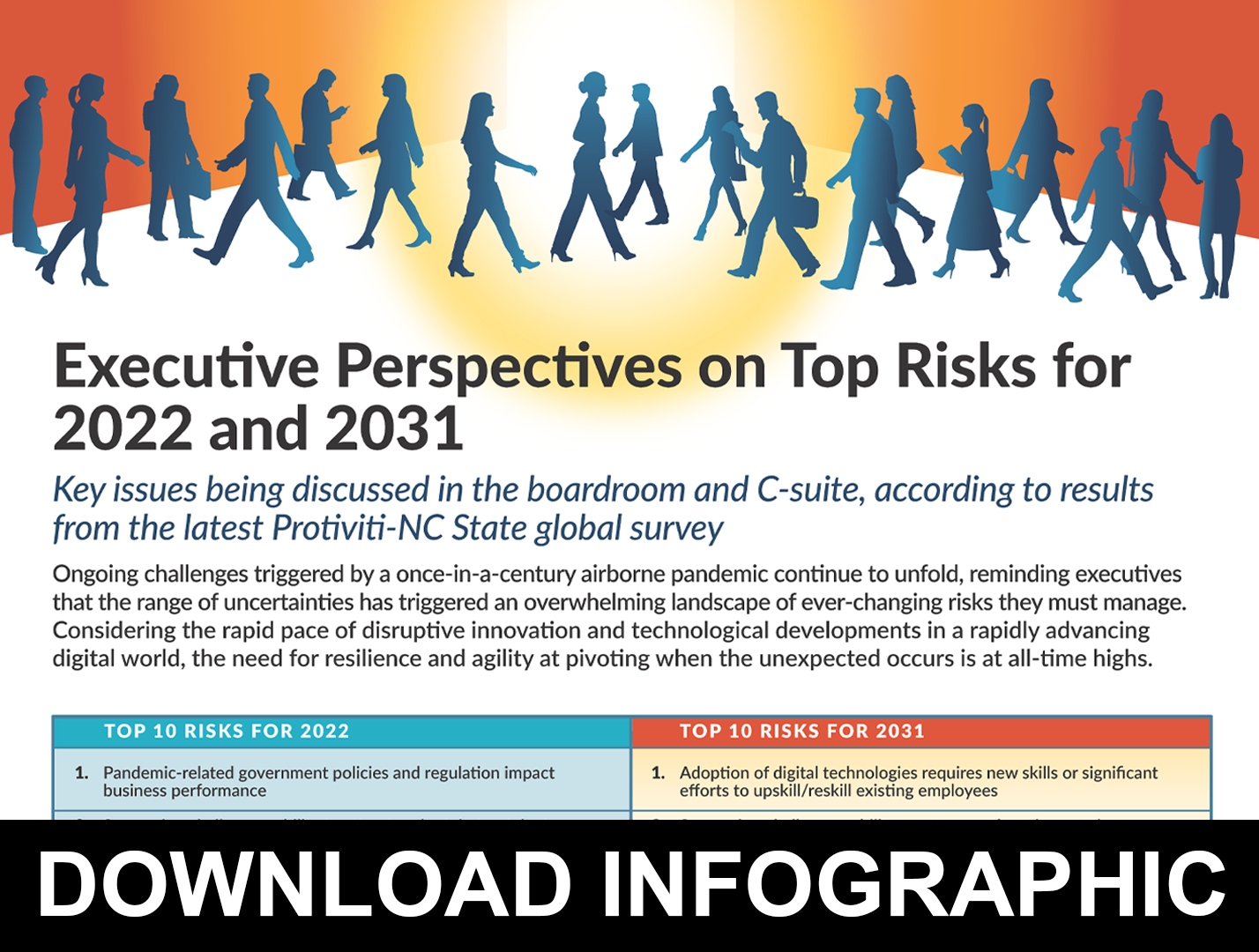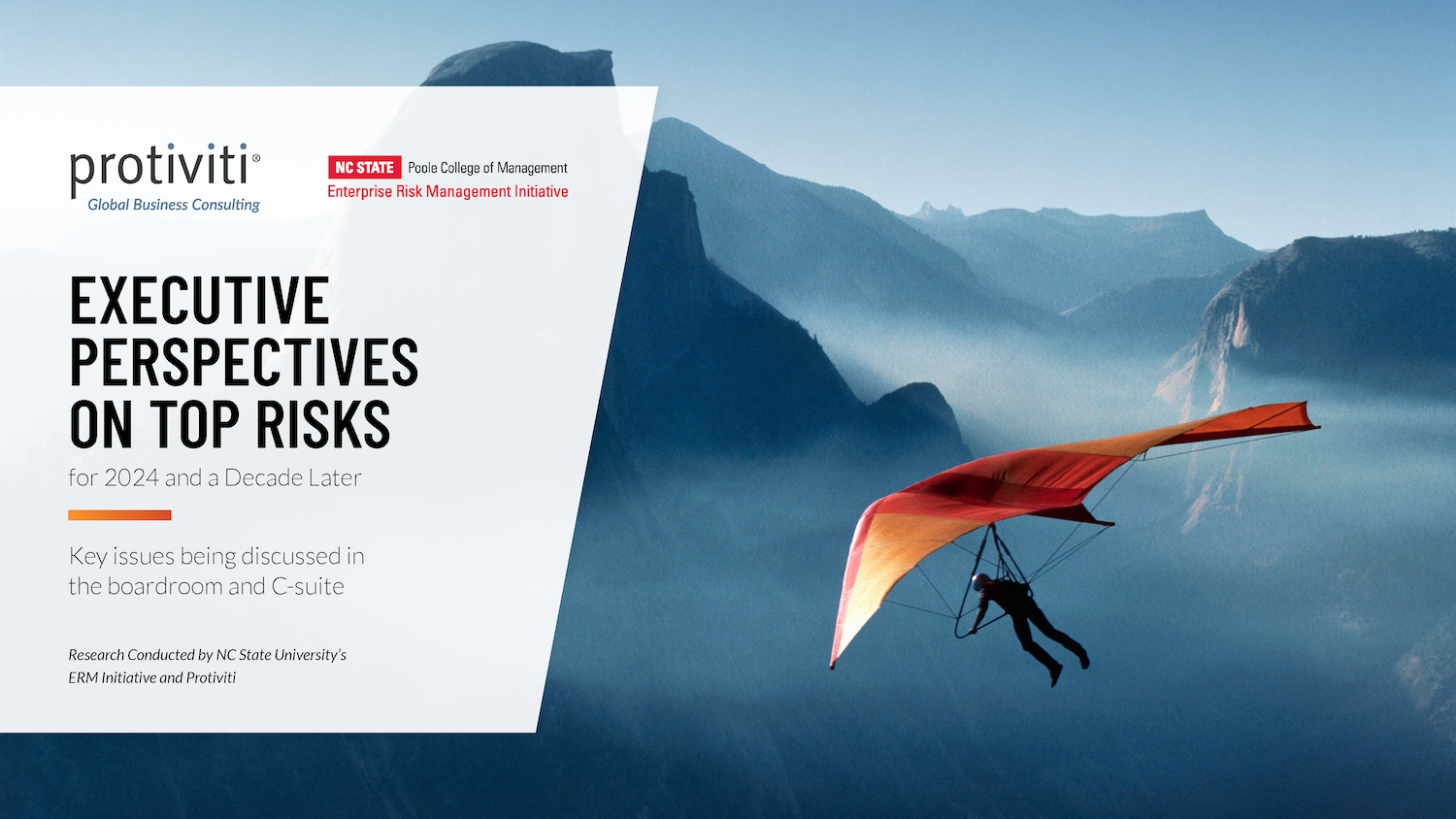REPORT: Executive Perspectives on Top Risks for 2022 & 2031
The ERM Initiative in the Poole College of Management at North Carolina State University, in conjunction with global consulting firm Protiviti, annually surveys boards of directors and C-suite executives about risks on the horizon for the upcoming year. This report, 2022 & 2031 Executive Perspectives on Top Risks, highlights top risks of immediate concern on the minds of executives for 2022 – and for the long-term – 2031.


Talent and Culture Risks Dominate
The survey report – the tenth annual such research report – assesses the concerns of 1,453 board members and executives globally, across a variety of industries. People and culture risk issues dominate the top list of risks for 2022, suggesting those issues are a top concern on the minds of these respondents as they navigate the war on talent.
There are several important risk themes related to people and culture with these making the top 10 list on the minds of executives:
- Succession challenges and retaining talent are a major concern. This risk moved from the 8th position in 2021 to the 2nd position in 2022. All sizes of organizations, with the exception of the very largest (those with revenues over $10 billion), rate this risk as a top five risk concern as do each one of our industry groups. Chief Executive Officers (CEOs), CFOs, and Chief Information/Technology Officers rate this as a significant impact risk for 2022.
- Rising labor costs is the sixth-ranked risk for 2022. This risk zoomed upwards from 23rd in 2021 to sixth for 2022. Clearly executives are concerned about attracting and retaining talent and must meet the table stakes the market requires to do so.
- Resistance to change is both a short-term and long-term risk concern. Executives are concerned that their organizations’ culture may restrict the organization from making necessary adjustments to the business model and core operations. This is a top 10 concern for both 2022 and 2031.
- DEI has elevated in importance. Shifts in perspectives and expectations about social issues and priorities surrounding DEI – the 10th rated risk overall for 2022 and 15th overall for the next decade — are forcing assessment of policies and processes around recruiting, retention, career advancement and reward systems.
- Workplace evolution is creating uncertainty. The pandemic accelerated trends that were already underway – specifically relating to remote work, e-commerce and automation. There is uncertainty over the impact of these changes on sustaining organizational culture and the way business is done. This is the ninth-rated overall risk concern looking out 10 years.
Challenges to Adopt Technologies and Emerging Innovations
Linked to immediate concerns about talent and culture are concerns about their organizations’ ability to have the capabilities to embrace emerging technologies and digital transformation necessary to compete in the rapidly evolving business landscape.
The future of work continues to be a defining business challenge for the next decade. Our survey results for 2022 indicate this risk is the fourth-ranked issue looking out 12 months and the top risk for the ensuing decade. Adoption of AI, automation in all of its forms, natural language processing, visual recognition software, virtual reality simulations and other digital advances are expected to displace as well as create millions of job functions.
This risk concern is a top five risk concern for the two largest size categories of organizations for 2022, but is a top five concern in 2031 for all four size categories. It is in the top five risks for 2031 in all industries except Energy and Utilities.
Concerns with the Global Pandemic Continue to Linger Near Term
The Delta and Omicron variants and inability to vaccinate enough people in some countries or provide sufficient doses of vaccines to other countries have sustained the pandemic, hamstringing recovery efforts and dampening economic growth sentiments. The root cause for two of the top five risks overall for 2022 are pandemic-related and involve leadership concerns about government policies significantly impacting business performance and pandemic-imposed market conditions continuing to impact consumer behavior and demand for products and services.
Top ESG Concerns Emphasize the “S”
Executives are focused on the importance of addressing risks related to the environment, social, and governance (ESG) issues.
- Most ESG issues rate highly, particularly with respect to the “S.” As noted above, people, culture and workplace issues are significant risks overall according to our survey. DEI-related challenges are a top 10 risk overall for 2022. There are risks associated with organizational culture, including resistance to change and the impact of the evolving workplace.
- Climate change concerns remain primarily isolated to industries heavily reliant on fossil fuels. Overall, climate change concerns represent one of the five risks reflecting the largest increases in severity between years. Oil and gas and power companies generating energy utilizing fossil fuels rate climate concerns as a top risk. Most other respondents do not perceive significant alterations in their strategy and business model for climate change as a near-term concern at this time, although the risk heightens looking out 10 years. This finding does not suggest climate change isn’t an important matter; it simply alludes to the current perception of many C-suite executives and board members outside of fossil fuels-based industries that climate issues will not significantly impact their organization’s strategy and business model.
Risk Differences Exist Across Various Characteristics of Respondents and Organizations
Like our prior studies, we conduct a number of analyses across different subsets of our sample, including analyses across sizes and types (i.e., publicly traded, private for-profit and not-profit/governmental) of organizations, industries and geography, and we are able to analyze the findings across different types of respondents (i.e., board members, CEOs, CFOs, etc.) Here are a few key insights from those sub-analyses:
- While risks triggered by the ongoing pandemic are top of mind for executives of all sizes of organizations, concerns about economic conditions in 2022 appear as a top five risk for three of the four size categories.
- There are varying views across different executive groups about the overall risk environment for 2022. Board members, chief risk officers (CROs), chief audit executives (CAEs) and chief data/digital officers (CDOs) have significantly decreased their 2022 risk expectations relative to 2021. In contrast, chief executive officers (CEOs), chief financial officers (CFOs), and chief information/technology officers (CIOs/CTOs) have the highest 2022 rating on this dimension. The increase is most dramatic for CEOs, jumping from 5.6 (the lowest rating) in 2021 to 6.6 in 2022 (the highest rating).
- There is significant disparity in the top five risks as opposed to previous years’ surveys. The Consumer Products and Services; Technology, Media and Telecommunications; and Healthcare industry groups all rate the macroeconomic risk of government policies surrounding public health practices as their top risk for 2022. The other three industry groups all identify different top risks. Financial services organizations cite concerns about the interest rate environment as their top concern. Respondents from the Manufacturing and Distribution industry group identified risks tied to uncertainty surrounding the organization’s core supply chain as their top concern, while those from Energy and Utilities identified risks related to succession challenges and the ability to attract and retain talent as their top risk concern.
- There are notable differences in views about risks around the globe, which is especially important for multinational organizations to consider. Organizations in Australia/New Zealand and Africa rate all five risks as “Significant Impact” risks whereas organizations in North America rated none of their risks as “Significant Impact” risks. There is variation in the nature and types of risks included in the top five risks for the eight geographic regions. Eighteen of the 36 risks appear in at least one geography’s top five list of risks. Only two risks are common to at least four of the eight regions.
The Top 10 Risks for 2022
The Top Risks for 2022
Survey respondents were asked to rate 36 macroeconomic, strategic and operational risks. The top risks identified for 2022 are:
- Pandemic-related policies and regulation may impact business performance
- Succession challenges may limit ability to attract and retain top talent
- Pandemic-related market conditions may affect customer demand and relationships
- Adoption of digital technologies may require significant efforts to upskill/reskill existing employees and attract new talent
- Economic conditions may constrain growth opportunities
- Labor costs may threaten ability to meet profitability targets
- Resistance to change may restrict needed changes necessary to adjust our operations and business model
- Inability to utilize sufficiently advanced data analytics and “big data” may limit abilities to achieve market intelligence and increase productivity, efficiency and innovation
- Cyber threats may disrupt our core business
- Shifts in expectations around social issues and diversity, equity and inclusion priorities may occur at a faster pace than the organization can manage
The Top Risks Through 2031
Survey respondents also rated the expected impact of the same 36 risks for 2031 to assess how the risk landscape might shift over the coming decade. According to survey respondents, concerns about the future of work are at the forefront, as the survey identified the following as the top 10 risks for 2031:
- Adoption of digital technologies may require significant efforts to upskill/reskill existing employees and attract new talent
- Succession challenges may limitability to attract and retain top talent
- Rapid speed of disruptive innovation may outpace our ability to compete
- Substitute products or services may arise that affect our business model
- Economic conditions may constrain growth opportunities
- Ease of entrance of new competitors may threaten market share
- Heightened regulatory change and scrutiny may affect operational resilience, products and services
- Resistance to change may restrict needed changes necessary to adjust our operations and business model
- Changes to the work environment/hybrid work may alter organizational culture and the ability to conduct business
- Inability to utilize sufficiently advanced data analytics and “big data” may limit abilities to achieve market intelligence and increase productivity, efficiency and innovation
Additional Resources Available to Learn More
In addition to the full report, 2022 & 2031 Executive Perspectives on Top Risks report from Protiviti and North Carolina State University, you may also download an Executive Summary and Infographic at the links below. A podcast highlighting the key results is also provided below.



<!–Download Transcript of Podcast–>
Partnership Between

- Categories:
- Types:


